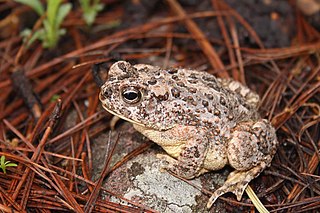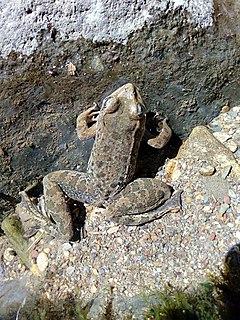
The southwestern toad or Mexican Madre toad is a species of toad in the family Bufonidae. It is endemic to north-western Mexico and found on the Sierra Madre Occidental in eastern Sonora and western Chihuahua and south to south-western Durango. Its natural habitats are conifer forests, commonly along low rivers and streams, its breeding habitat. It is a rare species threatened by habitat disturbance, including alterations causing the desiccation of streams and soils.
Rhinella veraguensis is a species of toad in the family Bufonidae. It is found in the Amazonian versant of the Andes and in the inter-Andean valleys in Bolivia and southeastern Peru. Its natural habitats are montane tropical forests and cloud forests. Breeding takes place in streams. There are no major threats to this common species, although it can locally suffer from habitat loss.
Nymphargus mariae, commonly known as Maria's giant glass frog, is a species of frog in the family Centrolenidae. It is found in the cloud forests of the Serranía de Sira, Huánuco, Peru and in Ecuador. A population endemic to Ecuador was previously considered to be a distinct species, Nymphargus puyoensis, but is now classified as a junior synonym.

The Chamula mountain brook frog is a species of frog in the family Hylidae endemic to Chiapas, Mexico. Its natural habitats are moist montane forests. It is threatened by habitat destruction and has been rated as "endangered" by the IUCN.
The pine forest stream frog is a species of frog in the family Hylidae found in Guatemala and possibly Mexico. Its natural habitats are subtropical or tropical dry forests, rivers, and heavily degraded former forest. It is threatened by habitat loss.
Craugastor ranoides is a species of frog in the family Craugastoridae. It is found in the southern Atlantic lowland of Nicaragua and northwestern Costa Rica, and through Costa Rica to extreme western Panama. Its natural habitats are, principally, lowland and premontane wet forests in association with small streams, but also dry forests with perennial streams. It is threatened by habitat loss and chytridiomycosis. The species has disappeared from much of its former range in Costa Rica, also in pristine habitats, possibly because of chytridiomycosis.
The Tonkin Asian frog is a species of frog in the family Dicroglossidae. Based on its known distribution, it is endemic to northern Vietnam, although it is considered likely that it also occurs in adjacent Laos and China. This poorly known species is presumed to be associated with small streams. Possible threats include collection for human consumption and habitat loss.
Quasipaa yei, or Ye's spiny-vented frog, is a species of frog in the family Dicroglossidae. It is endemic to China where it is known from the Dabie Mountains that straddle the border between Hubei, Henan, and Anhui provinces. Its type locality is in Shengcheng County in Jiyuan City, Henan. Its natural habitats are temperate rivers with surrounding forests. It is potentially threatened by habitat loss.
Quasipaa boulengeri is a species of frog in the family Dicroglossidae. It is known under many common names, including Boulenger's spiny frog, spiny-bellied frog, and Boulenger's paa frog. It is found in southern and southwestern China and northern Vietnam. It is a very common species that has declined. It is collected for human consumption, and it is also threatened by habitat loss. Its natural habitats are hill streams and ponds.

Quasipaa exilispinosa is a species of frog in the family Dicroglossidae. It is known under many common names, including Hong Kong spiny frog, common spiny frog, lesser spiny frog, little spiny frog, and Hong Kong paa frog. It has a patchy distribution in southern China including Hong Kong. Its natural habitats are subtropical hill streams in forests or shrublands, and sometimes also seepages, stream-fed marshes, and forests. It is threatened by over-collecting for human consumption and by habitat loss.
Quasipaa fasciculispina is a species of frog in the family Dicroglossidae. It is known under many common names: spiny-breasted giant frog, spiny-breasted frog, spine-glanded mountain frog, and Thai paa frog. It is found in the Cardamom Mountains in southwestern Cambodia and eastern Thailand. It is found in on near fast-flowing mountain streams in tropical evergreen forests. It is threatened by collecting for human consumption and by habitat loss.
Quasipaa jiulongensis is a species of frog in the family Dicroglossidae. It is endemic to eastern China and only known from the mountains of southwestern Zhejiang and adjacent Fujian above 800 m (2,600 ft) elevation. Its natural habitats are hill streams. It is threatened by habitat loss due to both logging and infrastructure development as well as by collection for food.
Quasipaa shini is a species of frog in the family Dicroglossidae. It is endemic to southern central China. Its natural habitats are rivers in subtropical moist lowland forests and montane forest at elevations of 510–1,500 m (1,670–4,920 ft) asl. It is threatened by over-collecting for human consumption and by habitat loss.

Quasipaa spinosa is a species of frog in the family Dicroglossidae. It is known under many common names, including Chinese spiny frog, giant spiny frog, Chinese edible frog, and spiny paa frog. Its names refer to the distinctive characteristics of the species, relatively large size and the spiny chest of male frogs. Giant in frog terms only, it can nevertheless grow to lengths above 10 cm (4 in); this makes it the largest frog in Hong Kong.
Odorrana kuangwuensis is a species of frog in the family Ranidae that is endemic to China. It is found in northeastern Sichuan and northwestern Hubei. Its name refers to the type locality, Mount Guangwu in Nanjiang County, northern Sichuan.
Odorrana nasuta is a species of frogs in the family Ranidae that is endemic to Hainan, China. It occurs near streams in forested regions at elevations of 350–850 m (1,150–2,790 ft) asl. Breeding takes place in streams. It is threatened by habitat loss caused by smallholder farming activities and clear-cutting of forests.

Zweifel's frog is an amphibian species endemic to Mexico. It is a member of the true frog family, Ranidae.
Boulenophrys binchuanensis, commonly known as the Binchuan horned toad, is a species of frog in the family Megophryidae. It is only known from northern Yunnan, China. Its type locality is Mount Jizu in Binchuan County. It is associated with mountain streams surrounded by forests. It is threatened by habitat loss associated with logging, road construction, and tourism.

Quasipaa is a genus of frogs in the family Dicroglossidae. The genus has no established common name, but many individual species are referred to as spiny frogs. They occur in East and Southeast Asia, from Thailand and Cambodia to southern and eastern China.
Quasipaa acanthophora is a species of frog in the family Dicroglossidae. It is endemic to northern Vietnam and know from two locations, its type locality Mau Son in the Lang Son Province, and the Tay Yen Tu Nature Reserve in the Bac Giang Province. It is a sibling species of Quasipaa spinosa.






